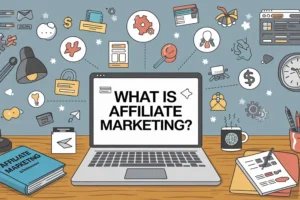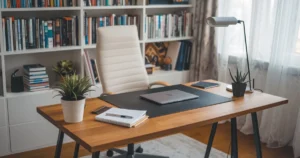What is Affiliate Marketing is the performance-based marketing technique, where individuals or businesses endorse other companies’ products or services. These affiliates earn a commission from each sale or lead generated due to their marketing efforts in promoting those products.

How Does Affiliate Marketing Work?
The process of affiliate marketing usually involves three parties:
The Merchant: The merchant is the company that produces the product or service.
The Affiliate: The person or business promoting the product or service.
The Customer: Who purchases the product or service through the link from the affiliate.
Here is only a simple outline of how it works :
Registration: The affiliate joins an affiliate program or a network and selects products or services to promote.
Marketing : The affiliate utilizes marketing channels to make products or services popular, which may encompass websites, blogs, social networks, and marketing by email.
Track: The Merchant’s system tracks the affiliate’s unique link so it knows how many clicks, leads and sales are being generated.
Earn: Every time a customer clicks on an affiliate’s link and makes a purchase, the affiliate is paid a commission.
The Basics of Affiliate Marketing
There are a few basic concepts that help one succeed in affiliate marketing:
Affiliate Link: This is a unique URL that will track the traffic and sales generated by an affiliate.
Affiliate Program: A program that lets a merchant provide an opportunity to promote the merchant’s products or services and acquire earnings on sales. Commission Rate: The percentage of the sale price earned by the affiliate as commission.
Cookie Duration: That duration the cookie of any affiliate stays active. A cookie is a text file that keeps track of the user’s activity on a website. As the customer clicks through an affiliate link, the cookie gets dropped onto the customer’s computer. When the customer makes a purchase within the cookie’s duration, the affiliate gets paid for his efforts on that sale.
Payout Threshold: This is the minimum amount an affiliate must earn to get his payment.
Taking these concepts as a basic point of understanding, you can start building your foundation right on affiliate marketing.
Choosing Your Niche: The Bedrock of Profitable Affiliate Marketing
Choosing the right niche is a crucial decision in your affiliate marketing journey. That’s rather like finding the perfect piece of land for your business. The right choice of niche may be crucial to success, but a bad one will leave you frustrated and with limited earnings.

Finding Your Passion
Identify what you’re passionate about: Find out what you can really get excited about. When you are enthusiastic about a subject matter, you are likely to keep creating interesting and relevant content, and you will be motivated to keep doing so.
Self-reflection on your hobbies and areas of interest, expertise
Assess your strengths or competencies.
Passion Projects: Scan any projects you have done in the past and select something you liked.
Market Research
After shortlisting a few niches, it’s time to do some market research and check whether the niche is profitable and how competitive it is.
Demand Analysis: By using tools like Google Trends, check if there is a demand for the niche.
Competition Analysis: Who else is offering it? What are their strengths and weaknesses.
Profit Potential: Research affiliate programs in your niche for potential revenue.
How to Find Profitable Niches
Here are some strategies on finding a profitable niche:
Niche Down: Instead of going with a broad niche like “health and wellness, niche down to such a specific topic as “plant-based diets for weight loss.”
Target a Specific Audience: Identify a specific audience within a niche that is “busy moms” or “tech-savvy professionals”.
You should look for high-paying affiliate programs where you can maximize your income. So, look for niches having high paying affiliate programs.
Consider evergreen niches-These are niches that exist at all times, such as personal finance, technology, and health. Example:
What you might need to be: In case you are a tech enthusiastic with the ability to explain complex concepts as simple ones, this niche, “smartphone reviews and comparisons,” might just be what the doctor ordered. Demand is high, and affiliate programs for smartphones and their add-ons are plentiful.
By following these tips, as well as from thorough research, you can find a profitable niche that suits your interest and goals. Remember, the right niche would remain at the heart of a lucrative business in affiliate marketing.
Finding Affiliate Programs: A Step-by-Step Guide
Affiliate marketing is one of the promising business models implemented on the internet in which you can earn some commissions from selling other people’s products or services. You first need to find good affiliate programs that are related to your niche and audience. For this, here is a detailed step-to-step guide to help you find and choose the right programs:

Popular Affiliate Networks
Affiliate networks represent a middle ground that brings the advertisers directly to the publishers. Such networks offer a diverse selection of different brands’ products and services, making it easy to find an affiliate program among them. Some of the most popular affiliate networks are:
Among the largest and best affiliate networks, Amazon Associates lets you promote an endless variety of products from books and electronics to clothing and home goods.
ClickBank is a network that focuses on digital products, including ebooks, software, and online courses. There are various niches under these categories, which in fact makes it popular among affiliate marketers.
CJ Affiliate, formerly known as Commission Junction is a big affiliate network connecting advertisers to various sorts of publishers in many industries. It has dozens of varieties with products and services that range from retail, to travel, finance, etc.
ShareASale: The other big network, with numerous diversified ranges of products and services; it has also fashion, beauty, health, with a very friendly interface for easy access to the user and very competitive commission rates.
Rakuten Marketing: Formerly LinkShare, it is a global affiliate network operating through many industries, connecting advertisers to publishers. Their products range from electronics, apparel, and home goods.
Direct Affiliate Programs
But many companies also offer direct affiliate programs. This is a way that you can market the products or services without the help of a third-party network. Some popular direct affiliate programs include:

Digital Products:
Udemy
Teachable
Skillshare
Web Hosting and Domain Names:
Bluehost
HostGator
GoDaddy
Software:
Adobe
Microsoft
E-commerce Stores:
Walmart
Target
Best Buy
How to Choose the Right Affiliate Program
When choosing which affiliate program to join, consider the following elements:

to the niche: The products or services should be highly related to your niche or audience interests.
Commission rates: Ensure you pick the ones offering competitive commission rates compared to what you provide and the value of products you promote.
Cookie durations: Those cookies that last longer are likely to fetch you more commissions as there’s more time to earn from the referred customer.
Payment terms: Look for programs with timely payments with little or no hassle in terms of payment schedules.
Product Quality: Look for high-quality products or services that your audience will value and trust.
Marketing Materials: Opt for programs that will give you tremendous marketing materials, such as banners, product descriptions, and email templates.
Support and Communication: A good affiliate program should be able to offer you good support and lines of communication in helping you succeed.
Considering all these factors will help you to choose the best affiliate programs and maximize your earnings for a sustainable online business.
Building a Strong Ground: Your Website or Blog
A website or blog is the ground on which you will base your affiliate marketing. It’s where you will store your content, attract visitors, and where all the conversion will take place – converting visitors to buyers.
Choosing a Platform
The first thing you need to decide is what platform you will use. This is primarily decided by what you are willing to do and what technical ability you have. Some of the most favorite options include:

WordPress: Very flexible and highly customizable, ideal for those who want full control over their site.
Wix: Easy drag-and-drop website builder for beginners.
Squarespace: A beautiful platform that is more on design and simplicity.
Elements to Consider About Your Website
After you have set up your website platform, here’s how you could focus on the elementary elements of your website:.
Web Hosting: Make sure your website is secure, reliable, and always up.
Professional Design: Develop a clean, beautiful, easy-to-navigate design.
High-Quality Content: Develop informative, value-generating content to attract your audience’s interests.
Call-to-Action: Ensure visitors take the action you want them to, with a clear call-to-action to click your affiliate links.
Fast Loading Speed: Optimize for speed, so both the user experience and your SEO will increase.
Mobile-Friendly Design: Make your website accessible and look magnificent on all devices.
Content Creation Strategies
Attract and retain visitors by creating good content. Here are some strategies:
Blog Posts: Informative, well-researched articles about topics relevant to your niche.
Product Reviews: Review the products or services you used and recommend them to your audience.
Tutorials and How-to Guides: Provide step-by-step guides that guide readers in solving problems.
Comparison Posts: Compare different products or services so that your audience can make the correct choices.
Listicles: List interesting tips, tricks, or suggestions.
SEO Best Practices
To get to your target audience, make sure to use SEO best practices:
Keyword Research Find relevant keywords and inject them organically in your content.
On-Page SEO Optimize titles, meta description, header tags and alt text of images.
Off-Page SEO Get backlinks from other websites.
Engaging Your Audience
To achieve a loyal following, make sure to engage with your audience.
Engage with Readers: Interact with them by writing comments and responding to the questions that people have about you.
Social Media: Share your content through multiple social media channels.
Email Marketing: Build an email list as well, and please do it sporadically.
Using all of these guidelines, creation of a successful website or blog is not so far-fetched and can easily help you realize your success in affiliate marketing.
Content Marketing for Affiliate Marketing
Organic way of promoting your affiliate link through content marketing. A good guide or informative content pertaining to a targeted audience can help build trust. Here’s how you can leverage content marketing:
- Blog Posts:
In-depth Guides : Create comprehensive guides on topics related to your niche. For example, if you are selling fitness products, then you could write a guide on “How to Build Muscle Mass at Home”.
Product Reviews: Honest and detailed reviews can really work. Point out the advantages and disadvantages of the product along with why it may be worth considering.
Comparison Posts: Compare similar products or services to help aid a choice in their decision.
- Video Content:
Product Demos: Show how a product works and its benefits
Tutorials: Educate the viewers on how to utilize a product or service
Vlogs: Your personal experiences and insights
- Social Media:
Share Valuable Content: Share links to your blog posts, videos, and other relevant content on social media.
Interact with Your Audience: Be sure to respond to comments and messages to build a relationship .
Host Contests and Giveaways: The incentive for people to share your content as well as follow your social media accounts.
Don’t forget:.quality over quantity-quality produces better results, no matter whether it is done less often.
Keyword Optimization: you ensure you are using the right words so that your content is optimized to appear in any search engine.
Call to Action: This is the process of putting across, quite clearly, what you want the audience to do. This may either include clicking an affiliate link, email list, or perhaps, making some purchase.
Search Engine Optimization (SEO)
SEO is about optimizing your site so that it would rank higher in search results. Through applying SEO best practices, you will be able to attract more people to visit your affiliate links organically.
Important SEO Strategy:
Keyword Research: Find the keywords relevant to searches your target audience is performing.
On-Page SEO: Optimize the Title tags, meta description, and Header Tags using relevant keywords.
Off-Page SEO: Get high-quality backlinks from other established websites.
Technical SEO Ensure your site is technically well-structured and easy for the search engines to crawl and index.
Pay Per Click Advertising
Pay per click advertising allows for the purchase of clicks on ads which can become a very effective means of sending targeted traffic to your affiliate link.
Popular PPC Platforms:
Google Ads: Reach a wide audience by showcasing your advertisement on Google Search Network and Display Network.
Bing Ads: Target users on the Bing search engine.
Social Media Ads: Sponsor on the channels like Facebook, Instagram, and Twitter.
Social Media Marketing
Affiliate marketing with social media is yet another highly effective means of marketing affiliate links. A great social media presence ensures you reach your target audience and drive traffic to the website.
Successful Social Media Tactics
Share Interesting Content: Publish useful and interesting content that your target audience would appreciate.
Run Contests and Giveaways: Get people to share your content and be a part of your social media profiles.
Collaborate with Influencers: Partner with influencers in your niche who can endorse your affiliate products.
Influencer Marketing
Influencer marketing is a concept which means teaming up with an influencer to market your affiliate products. You can use an influencer’s audience, thus expanding your reach, which could result in sales.
Key Considerations:
Select Right Influencers: Select an influencer with your business type and target audience.
Set Specific Objectives: This will tell you what you want to achieve from your campaigns.
Track Your Outcome: Monitor how the influencer marketing campaign you are running is performing, so continue improving.
Track Your Performance: The Deep Dive
Affiliate marketing calls for tracking and analysis of performance to be successful. This is achieved using the proper tools, as well as understanding which KPIs are the most important.
Popular Affiliate Marketing Tools
There are hundreds of tracking affiliate marketing tools at your disposal. Some of the top choices include:
Affiliate Networks Most affiliate networks have their tracking software. These tools can track earnings, clicks, and conversions for you.
Google Analytics The web analytics tool Google Analytics may also track affiliate traffic and conversion rates.
ClickFunnels The marketing funnel building powerhouse offers very robust analytic features. It helps you track sales funnels, email marketing, and affiliate performance.
Hotjar: a tracking tool about how your visitors behave in terms of clicking links, including those that lead to your affiliation offers;
Key Performance Indicators
Affiliate Marketing success is achieved through the monitoring of KPI. Below are a couple of important KPI metrics.
Click-through Earnings Per Click: They are the revenues or earning outcomes resulting from each link they click on on the basis of affiliate.
Conversion Rate: This is the rate at which visitors take a desired action. For example, if a person buys something, that means he has taken the desired action.
Click-Through Rate (CTR): This measures the percentage of people who click on your affiliate link.
Cost Per Acquisition (CPA): This metric measures the cost of acquiring a new customer.
Return on Investment (ROI): This calculates the profitability of your affiliate marketing efforts.
Analyzing Your Results
Now that you have collected your data, analyze it for trends and opportunities. Here are a few guidelines on how to analyze your performance.
Set Clear Goals: Determine what you wish to attain before tracking it. In this case, you want to increase the earnings every month, convert the rates or acquire more customers.
Track Regularly: You would track your KPI regularly to detect problems or trends in your operations.
Compare Performance: Compare your performance over time to make sure that you are indeed improving.
Test and Experiment: Try out different strategies and tactics at will.
Learn from Mistakes: Use failure as a learning experience.
Use effective performance tracking and analysis to optimize affiliate marketing efforts, maximize revenue.
Common Mistakes to Avoid in Affiliate Marketing
Affiliate marketing, though a good opportunity, is rife with pitfalls when approached hurriedly. Some of the most common mistakes that affiliates, new and old alike, should avoid include the following:
Choosing a Wrong Niche
One of the major errors is choosing a niche that is not of your interest or expertise. An unchosen niche with least interest doesn’t motivate hence, makes it hard to come up with interesting stuff to blog about. Moreover, a niche that is lowly profitable or highly competitive may drastically reduce your rate of gaining.
Avoid this:
By Passion Project: Choose a niche wherein you will genuinely be interested.
Market Research: Delve deep to find niches that are profitable and low in competition.
Audience Analysis: Know what their needs, preferences, and pain points are
Ignores Your Audience
You will totally fail at affiliate marketing if you just ignore the needs and preferences of your audience. Provide relevance in your content-to readers, not about marketing to them
How Not To
Active Listening: Pay attention to what your audience is saying through the comments, questions, and feedback.
Customized Content: Design your content according to their requirement and need.
Active Engagement: Be active using social media, emails, and comment posting so that you stay in contact with your audience.
Over-Promotion
While the concept is to promote the product of an affiliate, don’t overdo it. Over-promoting will alienate the audience. An aggressive sales pitch does more harm to your credibility and reputation.
Remember
Sneaky Promotion: Just integrate affiliate links naturally into the content.
Value First Principle: First, give them value, and then the promotion will follow.
Transparency : Inform them about the affiliations clearly so that they feel comfortable with you.
Failure to Practice Ethis
Ethics is significantly important in affiliate marketing. Unethical steps may lead you to penalties like banning the account or even lawsuits.
To avoid this:
Be honest in reviewing the product: provide an actual review with the drawbacks and positive aspects.
Be truthful with disclosures: clearly state the affiliation so that nothing remains hidden.
Never claim making false statements: be honest and not make exaggerated claims for any product.
Of course, staying clear of these common pitfalls will bring you that little bit closer to affiliate marketing success. The time and longevity of building trust define long-term success.
Building Firm Relationships with Affiliates
Nothing builds success in affiliate marketing than a successful relationship with your affiliates. Here is how to build such relationships:
Communicate Often: Keep the doors open and keep lines open between you and your affiliates. Update them regularly, discuss strategies, and deal with concerns whenever you get them.
Offer Value: Make sure you are providing the right value-added resources, such as marketing materials, training, and insights to help your affiliates succeed.
Be Transparent: Transparency of expectations and goals for the fosterment of trust and partnership
Give Incentives: commission rates that are as high as possible, exclusive deals to your best affiliates
Celebrate Success: in front of people, or in private, by writing a thank-you note, etc.
Consistency
The more consistent you are with your affiliate marketing business, the more it is likely to be a success. This is a list of some suggestions that will help you stay on track:
Create a Schedule: This may be making a content calendar for mapping your blog posts, social media updates, and other email campaigns in advance.
Set Realistic Goals: Divide your major goals into smaller, achievable tasks. This will help keep you motivated and on track.
Make Use of Automation Tools: Scheduling software and other platforms for email marketing are highly useful for automation of routine tasks and saving time.
Do Not Overwork: A person should avoid overworking. Regular breaks are the ways to rest and replenish your energy.
Be Positive: Never lose hope. Always expect that you will be successful.
The Secret of Mistakes
Everybody commits mistakes, but it is important to see how you learn from the mistakes. Here are some tips about learning from your mistakes:
Track Your Performance: Use analytics tools for monitoring your progress and areas to improve.
Analyze Your Failures: Take some time to understand why a certain strategy didn’t work.
Seek Feedback: Ask your audience and affiliates for feedback on the content and your marketing efforts.
Don’t Give Up: Use failures as a trigger to try new approaches and improve your skills.
Continuously Improving
The world of affiliate marketing is shifting every day, and if you are to stay in tune with it, your expertise and knowledge will have to soar to different heights every time. Here are some ways on that:
Be Updated: Catch the trend and find out the latest and best in industry
Attend Webinars and Conferences: Network with other affiliate marketers and get knowledge from industry experts
Take Online Courses: Invest in your education to earn digital marketing, SEO, and content creation courses.
Experiment With New Strategies Do not be afraid to try new things and experiment with different marketing tactics.
Seek Mentorship: Consider seeking the direction of a mentor who can provide a guiding light.
By using these tips, you will have a very powerful affiliate marketing business that will bring home the good money.
Conclusion
The affiliate marketing is one of the best ways for making huge amounts of money on the internet. You will have a very successful internet business once you know what it involves by being mindful of the basics, what niche to choose, and promoting your products most appropriately.
Key Takeaways:
What is Affiliate Marketing? This is a performance-based marketing approach where one markets another’s products or services and receives some kind of commission every time an individual makes a purchase or generates a lead.
How to Get Started Step 1 Choose a Niche Find Affiliate Programs Create High-Quality Content Promote Your Affiliate Links Through Various Channels The Need for Tracking Monitor your performance using affiliate marketing tools and make decisions based on data. Ethical Considerations Be transparent with your audience and present them with ethical practice. Ready to Start Your Affiliate Marketing Journey?
Do not be afraid of the online universe. Start in one niche and then build slowly. Devote yourself intensely, and eventually you will discover you are earning big money through affiliate marketing.
The Future of Affiliate Marketing
The future of affiliate marketing is bright. Along with technological advancement, comes a great deal of new opportunity in affiliate marketing. Keeping up with the trends of your industry and living up to change in consumers’ behavior patterns while embracing innovation in terms of marketing will help prosper in that dynamic industry.







